Question from Nelson J.:
Not an earth shattering question but who took out the first patent for bottled water??
Nelson J.
Continue reading “Invention Geek – First Patent for Bottled Water?”

Question from Nelson J.:
Not an earth shattering question but who took out the first patent for bottled water??
Nelson J.
Continue reading “Invention Geek – First Patent for Bottled Water?”
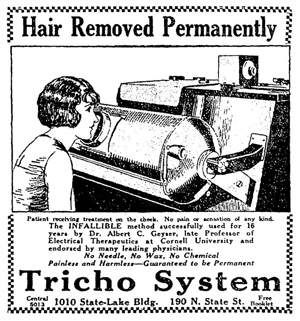 On November 8, 1895, German physicist Wilhelm Röntgen discovered x-ray. The invention was a major scientific breakthrough and the world became fascinated with x-rays. Amazingly, people could now see their bones. X-rays were quickly embraced by physicians and scientists around the world. Physicians began using the machines in their offices. A shoe fitting device using x-rays was patented. There was even a system designed using x-rays to remove excessive hair.
On November 8, 1895, German physicist Wilhelm Röntgen discovered x-ray. The invention was a major scientific breakthrough and the world became fascinated with x-rays. Amazingly, people could now see their bones. X-rays were quickly embraced by physicians and scientists around the world. Physicians began using the machines in their offices. A shoe fitting device using x-rays was patented. There was even a system designed using x-rays to remove excessive hair.
Albert C. Geyser invented the Cornell Tube in 1905. The tube was thought to be a safer form of X-rays. The Cornell tube was an X-ray vacuum tube made of leaded glass with one area of regular glass for shinning an ultra-soft x-ray directly on a small spot of skin. The tube supposedly did not emit extra rays and so it reduced the possibility of being burned by the x-rays.
Geyser used this tube to create the Tricho system. The machine was used to remove unwanted hair from the chin, cheeks and upper lips of women by using direct x-rays. Women sat in front of a cabinet with a window where the x-ray came out. A switch turned on the machine though it seemed like nothing happened besides a slight hum. The machine then switched off automatically. Continue reading “X-Rays To Remove Hair?”
Question from Emma R.:
Hey Geek,
Is it true that Levi Strauss has sued other jean designers over their back pocket stitches?
Emma
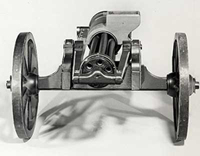 John Gatling was not a man out to promote war and the killing of men with his invention. Instead, Gatling believed that the invention of an automatic weapon would reduce war and the death of soldiers. He thought because the gun would have such a devastating effect on the armies, once seen on the battlefield it would send the other side running. In addition, a weapon that had the impact of many men when used by few would reduce the number of soldiers needed thereby reducing the number of casualties.
John Gatling was not a man out to promote war and the killing of men with his invention. Instead, Gatling believed that the invention of an automatic weapon would reduce war and the death of soldiers. He thought because the gun would have such a devastating effect on the armies, once seen on the battlefield it would send the other side running. In addition, a weapon that had the impact of many men when used by few would reduce the number of soldiers needed thereby reducing the number of casualties.
It occurred to me that if I could invent a machine – a gun – which could by its rapidity of fire, enable one man to do as much battle duty as a hundred, that it would, to a large extent supersede the necessity of large armies, and consequently, exposure to battle and disease [would] be greatly diminished. – John Gatling
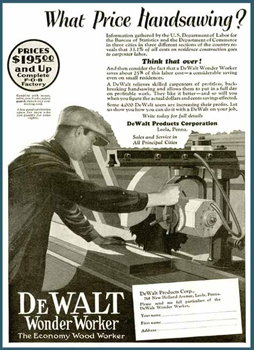 Raymond E. DeWalt followed in the family tradition working in mills and construction. The jobs were difficult and labor intensive. DeWalt was always looking for ways to cut costs, make jobs easier and be more efficient. His solutions often included creating machines to help with the work.
Raymond E. DeWalt followed in the family tradition working in mills and construction. The jobs were difficult and labor intensive. DeWalt was always looking for ways to cut costs, make jobs easier and be more efficient. His solutions often included creating machines to help with the work.
This ingenuity eventually led to DeWalt becoming the supervisor of a woodworking mill that produced a bit of everything from boxes to houses. The workload at the mill was more than the employees could handle. The company would not increase payroll to hire more help. DeWalt had to, instead, find ways to make his current staff more productive. To make this happen, DeWalt began designing more devices and machines.
One of these machines would become the first radial-arm saw. DeWalt created a special yoke which was attached to an electrical powered saw then mounted to a standard arm. The saw was then movable. It could be raised, lowered, slid back and forth, moved to an angle or tilted to make a bevel. This new saw was extremely useful and allowed one man to do the work of four. Labor costs were cut in the mill while productivity was greatly increased. Continue reading “The First Radial-Arm Saw”
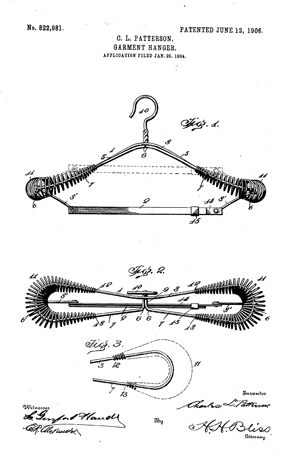 The coat hanger was invented in response to a lack of coat hooks in an office building in Jackson, Michigan in 1903. Albert J. Parkhouse worked for Timberlake Wire and Novelty Company which made lampshade frames and other wire items. One day, he arrived at work to discover that all the coat hooks were occupied. Parkhouse did not like having his winter coat getting wrinkled on the back of a chair all day. He decided to find a solution.
The coat hanger was invented in response to a lack of coat hooks in an office building in Jackson, Michigan in 1903. Albert J. Parkhouse worked for Timberlake Wire and Novelty Company which made lampshade frames and other wire items. One day, he arrived at work to discover that all the coat hooks were occupied. Parkhouse did not like having his winter coat getting wrinkled on the back of a chair all day. He decided to find a solution.
The company produced wire products so there was always wire laying around. Parkhouse grabbed a piece of this wire and twisted it into in two ovals with the end twisted together to form a hook. Another piece was twisted to fit inside the shoulder of his coat. The last piece curled in the center. His new wire creation allowed him to hang his jacket anywhere.
He continued to perfect his invention. Eventually all of the employees were using hangers created by Parkhouse. The company saw the potential of this idea and they applied for a patent for the invention. Because the hanger was created at work, Timberlake Wire and Novelty Company owned the rights to the product. Continue reading “Twisted Wire = Coat Hanger”
Question from Dylan T.:
Dear Geek,
Did Charles Moncky really invent the Monkey wrench?
Thanks,
Dylan
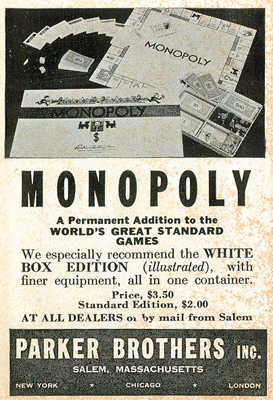 Charles Darrow, an unemployed man living in Germantown, Pennsylvania, created the board game Monopoly in the evenings while trying to make ends meet during the day. In the game, all players have the chance to buy and sell real estate. Living during the great depression, this board game gave the hard pressed workers of the time a chance for fantasy and distraction from their difficult lives.
Charles Darrow, an unemployed man living in Germantown, Pennsylvania, created the board game Monopoly in the evenings while trying to make ends meet during the day. In the game, all players have the chance to buy and sell real estate. Living during the great depression, this board game gave the hard pressed workers of the time a chance for fantasy and distraction from their difficult lives.
Darrow showed his new board game to Parkers Brothers executives and they rejected the idea. They stated that the game had at least fifty-two design flaws including that the game was way too long, the rules were difficult to follow, and there was no real goal for the winner. With help from a friend who was a printer, Darrow went on to manufacture the game himself. He sold 5,000 copies to a local Philadelphia department store. The game was hit. Everyone loved it.
Darrow filed for a US patent on August 31, 1935. On December 31, 1935, he received patent #2,026,082 for a board game apparatus.
One of the copies of the game was bought by the daughter of the founder of Parker Brothers. She suggested that her father take another look at the game. Parker Brother decided to license the patent rights from Darrow. Very quickly, Monopoly was selling over 20,000 copies a week. It was the best selling game in 1935. Darrow went from working odd jobs to get by to a very rich man quickly with the success of his game. Continue reading “The True Monopoly History…”
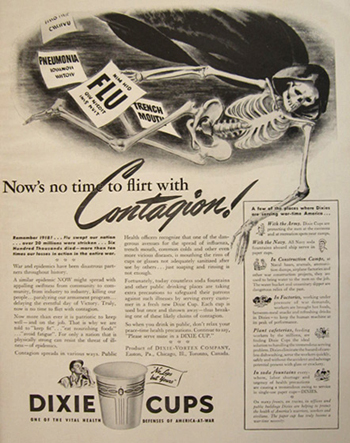 Today, paper cups seem like something that of course everyone uses. No one would ever share a cup with a stranger just to have a drink of water. The diseases that could spread this way are apparent to us all. But until the beginning of the 20th century, this was not the case. Everyone drank out of the same water source with a shared glass, drinking tin or dipper.
Today, paper cups seem like something that of course everyone uses. No one would ever share a cup with a stranger just to have a drink of water. The diseases that could spread this way are apparent to us all. But until the beginning of the 20th century, this was not the case. Everyone drank out of the same water source with a shared glass, drinking tin or dipper.
In 1906, a conference which brought together doctors from across the United States to discuss sanitation conditions on the railroads brought attention to the germs spread by drinking fountains and these shared drinking containers. Lawrence Luellen became interested in the idea of creating an individual drinking cup in 1907. He wanted to have the ability to dispense clean pure drinking water into clean, germ-free paper cups to help the spread of disease.
Luellen invented a water vending machine with disposable cups. With a fellow Bostonian, Hugh Moore, he began a program to educate people about the advantages of individual paper cups. Together they formed the Individual Drinking Cup Company to sell their machines and cups to railroad companies. By 1912, the company had produced a semi-automatic machine to dispense the individual cups they had named Health Cups. Continue reading “Health Cups?”
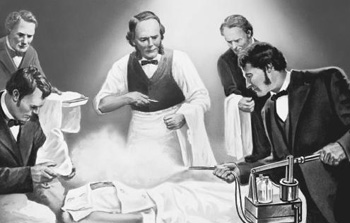 Joseph Lister helped make surgery a much safer undertaking. Before Lister’s discovery, surgery was a last resort because of the high rate of post-operative infections. People believe that it was bad air in a hospital that caused infections after surgery. Preventative measures to prevent infections and diseases included airing out a hospital during the day.
Joseph Lister helped make surgery a much safer undertaking. Before Lister’s discovery, surgery was a last resort because of the high rate of post-operative infections. People believe that it was bad air in a hospital that caused infections after surgery. Preventative measures to prevent infections and diseases included airing out a hospital during the day.
Pasteur’s research which showed that the presence of micro-organisms caused rotting and fermentation was the basis for Lister’s research to make surgery safer. Pasteur suggested three ways to eliminate these organisms. One of these methods was exposure to chemical solutions.
Carbolic acid, a chemical which was used to deodorize sewage, was Lister’s chemical of choice. In August of 1865, Lister experimented with the chemical on the leg fracture of an eleven year old boy. He applied bandages dipped in carbolic acid to the leg wound. He removed the first bandages after four days and there was no sign of infection. After continuing to dress the wound with carbolic acid for six weeks, the boy’s leg healed perfectly with no signs of infection.
Continue reading “The Father of Modern Antisepsis”